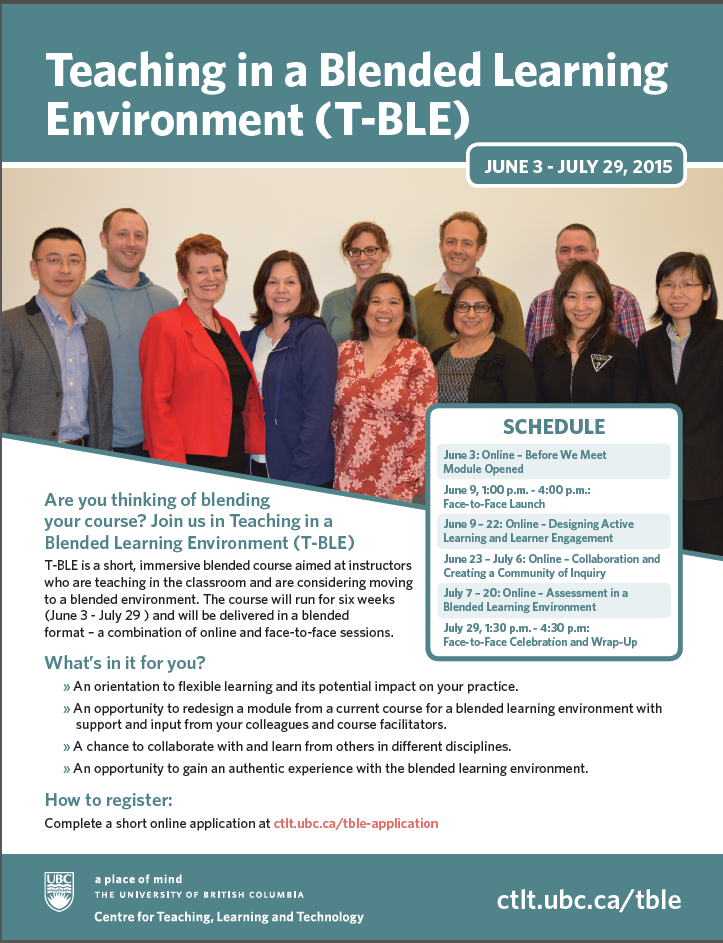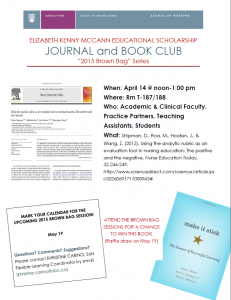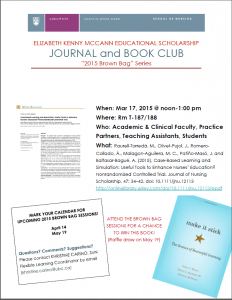Hello everyone,
Thank you to all who attended the Elizabeth Kenny McCann Educational Forum on Wednesday November 26th. We had great discussions surrounding technological and online learning, education and learning within the UBC School of Nursing, and innovative ideas regarding the future of education. Below is a summary of the key points of interest for this year’s event. Here are the slides used during the presentation: EKM Forum 2014
The forum kicked off with a group activity where participants were asked to discuss one of four topics related to teaching and learning:
- What are the current gaps in provision of educational-technology support in the School of Nursing?
The group assigned to this topic broke it down into four main areas of concern: equipment (lack of tablets, old computers, monitors, and video cards), programming (lack of access to software i.e. trying to get up to speed with ATI), support (lack of IT support i.e. being able to sync hand-held devices with work station computers), and time (delays in terms of requests from IT and trying to learn new technologies in the midst of demanding workloads).
- From an IT infrastructure point of view, pedagogically what would you like to accomplish in the future that you are not able to do today?
The group assigned to the second topic brainstormed several ideas, such as video capture tools, a technology sandbox that would serve as a space to “try things out” without having to wait for support, secure collaborative online tools for faculty and students, and repository. Others outside the group expressed the need to sync the portal and the website. An underlying theme throughout these departments was said to be a lack of good quality support.
- What educational technology support and/or service do you need to realize your teaching goals?
Several helpful resources were identified by the third group: a resource person available in a timely manner, demonstrations on how to use new technological features, simple ‘how to’ guidelines that are easily understandable, regular educational events, ways to support student engagement, better role clarity, funding to update technological support, and proactive support, where help is offered when it’s needed. One attendee mentioned the importance of distinguishing between flexible learning and IT, and to remember that technology is a facilitating tool for flexible learning.
- How should the university measure and report effectiveness of its learning ecosystem?
The fourth group suggested evaluation at both the project and program levels. At the project levels, a systematic student and faculty survey was recommended. They emphasized the need to utilize both qualitative and quantitative approaches, as well as finding out what students and faculty consider a success. At the program level, communication, the need to find metrics across outcomes and student feedback were highlighted.
Next we revisited the topic and role of clinical simulation in the undergraduate program which was previously discussed in a journal club meeting.
Positive Use for Simulation:
- the ability to simulate high risk events which are often quite infrequent and absent from clinical practice
- increased incidences to improve decision- making skills
- ability to offer a safe learning environment; free of toxic interactions growing within the workforce
- reduce learning delays that occur with each rotation change
- increase learning opportunities within rotations that have difficulty securing placements
Negative Use for Simulation:
- narrow view of the “real world,” for example, patient and family interaction and unexpected events; “there is nothing more bizarre than reality”
- hard to simulate interpersonal conflict
- risk of losing the complexity of a situation and how a unit functions
- expectation are different in a simulation versus clinical practice
Different participants also voiced the importance of defining exactly what simulation is. Simulation can be considered an umbrella term that does not only include a lab setting with a mannequin but rather the clinical environment as a whole where interactions and more can be manipulated and presented as they would appear in a clinical setting.
When posed with the question, “How much clinical time do you think we should replace with simulation in a BSN program?” there was some differences of view. The majority of the group chose 25% or less.
Teaching & Learning Strategies for Flexible Learning
Dr. Maura MacPhee and Marc Legacy spoke about varied FL teaching and learning strategies as well as applications for curriculum and design. The following are some key points for their discussion:
- Memory research: while students often study by reading material repetitively, this method is not the most effective way to retain information. Self-testing throughout the study process has been reported to enhance retention and promote more effective learning.
- Formative testing evidence: short answer testing was found to increase retention of information compared to multiple choice testing.
- Spacing effects: it’s better to distribute learning over time, and revisit and build on concepts in a thoughtful manner in order to maximize learning. How to thoughtfully connect concepts between thread course levels is a key area of focus in our curriculum at the moment.
- Pushing students outside of their comfort zone has been shown to create additional brain pathways. For example, asking bridging questions such as identifying the differences between human and giraffe kidneys stimulates learning and enhances retention compared to a simple human anatomy lesson.
- Threshold concepts: it’s important to base curriculum on threshold concepts, which are concepts central to learning and mastering.
- Jewels in the curriculum: focus on “jewels” for richer, complex insights. Listen to students when they are struggling and pay attention to how they are shaping their knowledge. Use this as a diagnostic to then solve the problem.
- There’s a level at which students learn concepts with more complexity. Without the support they need to reach this level, students resort to plagiarism.
- Curriculum redesign: issues with curriculum design can be identified by looking at retention from one term to the next. Students should be involved in curriculum redesign.
Dr MacPhee also discussed the need to adapt to the increasingly technological world we live in. How is authenticity maintained in teaching and learning with an increase in technology? How are students kept engaged and motivated to become active learners; online authenticity versus face to face? It’s important to be present online and in the classroom for both teachers and students. In regards to students, there was a comment made about how being physically present by signing on to an online forum is not enough but to actually engage with meaning and purpose is considered to be present.
Also presented was a study that looked at three components of learning activities which go hand in hand; these included worked examples, practice workouts and matched assignments. Worked examples were a way for students to check their reasoning rather than just checking if they had the correct answer. The rationale would model the way one would think about a problem instead of just providing an answer. Practice workouts were a series of questions that provided students with questions similar to the ones they would be evaluated with. Matched assignments are assignments that are matched to the skill or knowledge base of the student it is given to. Giving students assignments matched to their appropriate skill level helped them retain the information better. Weak students would receive questions closer to their level at an incremental progression to help build and establish a base of knowledge with confidence.
Getting Started with Publishing in SoTL
Dr. Bernie Garrett gave an overview and tips on how to get started in publishing in the scholarship of teaching and learning field. See the attached slides for details of the presentation.
Conclusion
The session ending with a discussion on the planned revisions of the current BSN program. Overall, the event was a success, Thank you to everyone who participated in the Elizabeth Kenny McCann Education Forum as well as the Journal Clubs and Workshops throughout the year. Your contributions made each session unique.






